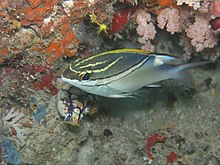Scolopsis
| Scolopsis | |
|---|---|

| |
Two-lined monocle bream , (S. bilineata)
| |
| Scientific classification | |
| Domain: | Eukaryota |
| Kingdom: | Animalia |
| Phylum: | Chordata |
| Class: | Actinopterygii |
| Order: | Spariformes |
| Family: | Nemipteridae |
| Genus: | Scolopsis G. Cuvier, 1814 |
| Type species | |
| Scolopsis sayanus Gilliams, 1824
| |
| Synonyms[1] | |
Scolopsis is a
Taxonomy
Scolopsis was first proposed as a genus in 1814 by the French
Etymology
Scolopsis combines scolo, meaning "thorn", with opsis, meaning "face", thought to be referring to the large backwards pointing spine on the suborbital or the serrated rear margin of the
Species
The currently recognized species in this genus are:[6][7]
- Scolopsis affinis W. K. H. Peters, 1877 (Peters' monocle bream)
- Scolopsis aurata (M. Park, 1797) (Yellowstripe monocle bream)
- Scolopsis bilineata (Bloch, 1793) (Two-lined monocle bream)
- Scolopsis bimaculata Rüppell, 1828 (Thumbprint monocle bream)
- Lacépède, 1802) (Saw-jawed monocle bream)
- Scolopsis curite Cuvier 1815 (Whitecheek monocle bream)
- Scolopsis frenata (Cuvier, 1830) (Bridled monocle bream)
- Scolopsis ghanam (Forsskål, 1775) (Arabian monocle bream)
- Scolopsis japonica (Bloch 1793) (Javanese monocle bream)
- Scolopsis lacrima Nakamura, Béarez & Motomura, 2019 (Teary monocle bream)
- Scolopsis lineata Quoy & Gaimard, 1824 (Striped monocle bream)
- Scolopsis margaritifera (Cuvier, 1830) (Pearly monocle bream)
- Scolopsis meridiana Nakamura, Russell, Moore & Motomura, 2018 (Sahul monocle bream)
- Scolopsis monogramma (Cuvier, 1830) (Monogrammed monocle bream)
- Scolopsis taeniata (Cuvier, 1830) (Black-streaked monocle bream)
- Scolopsis taenioptera (Cuvier, 1830) (Lattice monocle bream)
- Scolopsis temporalis (Cuvier, 1830) (Bald-spot monocle bream)
- Scolopsis trilineata Kner, 1868 (Three-lined monocle bream)
- Scolopsis vosmeri (Bloch, 1792) (Vosmaer’s monocle bream)
- Scolopsis xenochrous Günther, 1872 (Oblique-barred monocle bream)
Characteristics
Scolopsis monocle breams are small to medium sized fishes with slender to moderately deep bodies that are laterally compressed. They have brush like or small conical shaped teeth arranged in tapering bands in both the upper and lower jaws but there are no canine-like teeth. The
Distribution and habitat
Scolopsis monocle breams have a wide distribution in the Indian and Western Pacific Oceans. They are benthic fishes, typically found at deoths arf 60 m (200 ft) or less on reefs or on sandy or muddy substrates.[8]
Biology
Scolopsis monocle breams may be found as individuals or in
References
- ^ Nicolas Baillie (2019). "Scolopsis Cuvier, 1814". WoRMS. World Register of Marine Species. Retrieved 20 November 2023.
- ^ Eschmeyer, William N.; Fricke, Ron & van der Laan, Richard (eds.). "Genera in the family Nemipteridae". Catalog of Fishes. California Academy of Sciences. Retrieved 20 November 2023.
- .
- OL 25909650M.
- ^ "Order SPARIFORMES: Families LETHRINIDAE, NEMIPTERIDAE and SPARIDAE". The ETYFish Project Fish Name Etymology Database. Christopher Scharpf. 17 October 2022. Retrieved 20 November 2023.
- ^ a b Froese, Rainer and Pauly, Daniel, eds. (2023). Species of Scolopsis in FishBase. October 2023 version.
- ^ Eschmeyer, William N.; Fricke, Ron & van der Laan, Richard (eds.). "Species in the genus Scolopsis". Catalog of Fishes. California Academy of Sciences. Retrieved 20 November 2023.
- ^ a b c Russell, B.C. (1990). Nemipterid fishes of the world. (Threadfin breams, whiptail breams, monocle breams, dwarf monocle breams, and coral breams). Family Nemipteridae. An annotated and illustrated catalogue of nemipterid species known to date (PDF). FAO Species Catalogue. Vol. 12. FAO. pp. 96–97.
